Weather and Climate | Home / Weather and Climate / Foehns winds
Foehn winds
Definition
Foehn winds (also spelled Föhn winds) are meteorological phenomenon that happens when prevailing wind meets a mountain range. The result of this interaction is a dry and warm down-slope wind on the downwind side of the mountain range.
Where does the word Foehn come from?
The name Foehn come from the Swiss German Föhn which come from the Latin favōnius, a mild west wind. After it was adopted by the German Alpine dialects and designated a strong, dry and warm wind of the German Alps. This wind is where the phenomenon was first studied.
How do foehn winds form?
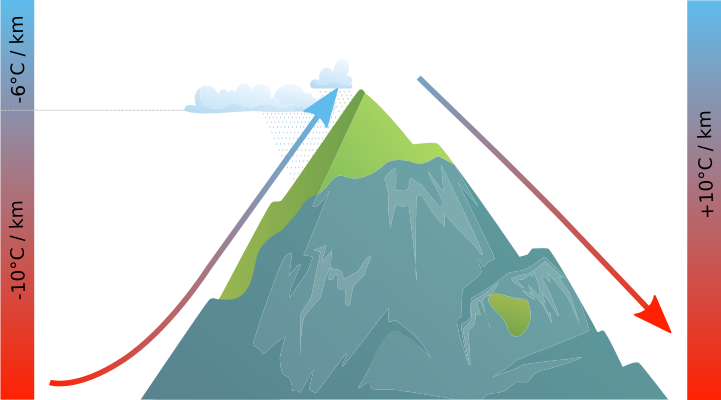
When the wind meets a mountain more or less perpendicularly, it follows the relief and rises. The atmospheric pressure decreases with the altitude and as a result the temperature of the air decreases by adiabatic expansion following the dry adiabatic lapse rate.
If the humidity is high enough at the beginning, since colder air can hold less water vapor, moisture will condense on the altitude point where saturation is reached (condensation level). So cloud will form and precipitation as rain and/or snow will occurs on the mountain’s upwind slopes.
The change of state from vapor to liquid water heats the air and partially counter the cooling of the air while it rises. Indeed, solar radiation, which provided heat and allowed the water to evaporate at ground level, is returned to the air by latent heat. The rate of decrease in the temperature of the air parcel will therefore be from this moment according to the saturated adiabatic lapse rate, as long as there is steam to condense. The rate of temperature variation for the dry air (dry adiabatic lapse rate) is around 10°C /km (around 5.5 °F per 1,000 ft) and of around 6°C / km (around 3.3°F per 1,000 ft) for saturated air (moist adiabatic lapse rate).
The Foehn effect don’t always produce rain, snow or even thick clouds on the upwind side. When there is no precipitation on the upwind side, and that if any clouds they have evaporated, then the temperature between the 2 sides of the mountain range are the same for the same altitude.
Consequences of Foehn wind?
They can be responsible for a difference of climate between each side of the mountain range. Indeed, when the upwind side is affected by rain and clouds, the down slope is affected by a dry and warm wind. This can be benefit, for example for vineyards, but this can also lead to desert on the down slope side of the mountain range. It can also be problematic for forest fire like it is the case in California.
Because of the strong wind, it can also create damage on the buildings and infrastructure.
Finally, the Foehn wind is also responsible for the sudden smelting of snow in regions where they are active.
Where are Foehn winds found?
These winds are found everywhere in the world where the prevailing wind meets a mountain range more or less perpendicularly. This phenomenon is global but, because the general circulation of the wind is along the parallels, it can be found at every mountain range oriented North – South.
Foehn winds in California – Oregon and desert
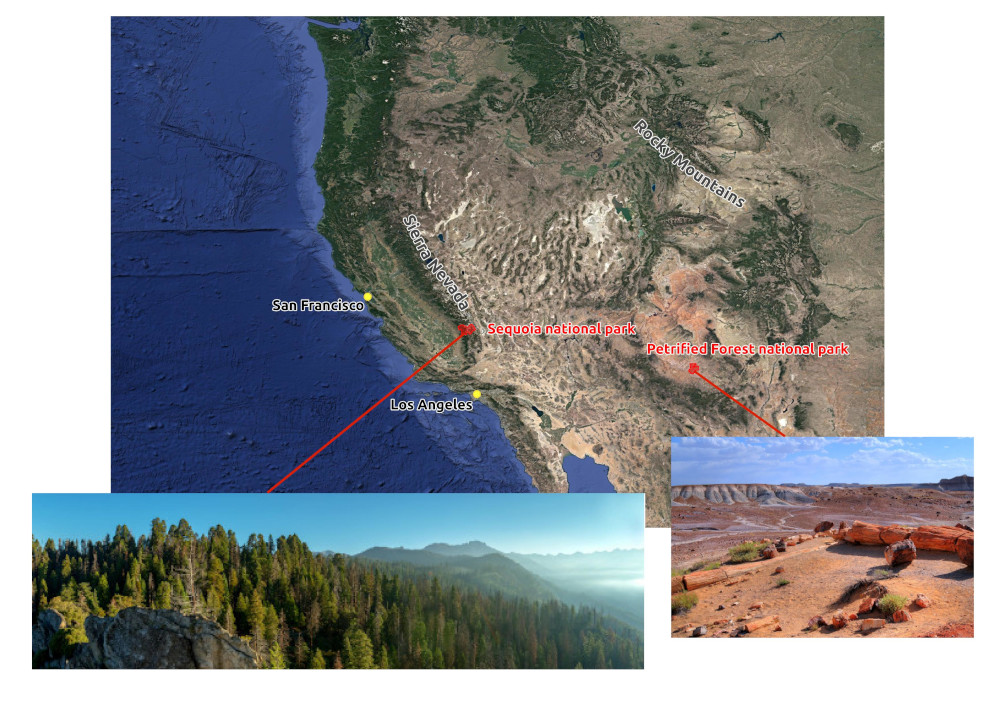
Like explain in a previous chapter, Foehn winds can be responsible for desertification. One example of this is the Sequoias and the Petrified forest on the United States west coast.
Until the Eocene the Rocky mountains and the Sierra Nevada mountain ranges were not so high and the Foehn had no effect on the lee (downwind side) because the air parcel didn’t go high enough to cross the condensation level. So the air parcel was following the dry adiabatic lapse rate on both sides of the mountain range and the vegetation was luxurious on both sides.
Then started the uplift of the Rocky mountains and the Sierra Nevada mountains. As a result the mountain range crosses the condensation level, and the upwind side began to be under clouds and precipitation condition. Because of this lose of water, the dry adiabatic lapse rate is reached more early on the downwind side. As a result the temperature on the lee is higher for the same altitude on the upwind side.
Like explain in the previous chapter the general circulation of the wind is along the parallels and so we can find the same type of desert on mountain range oriented North – South.
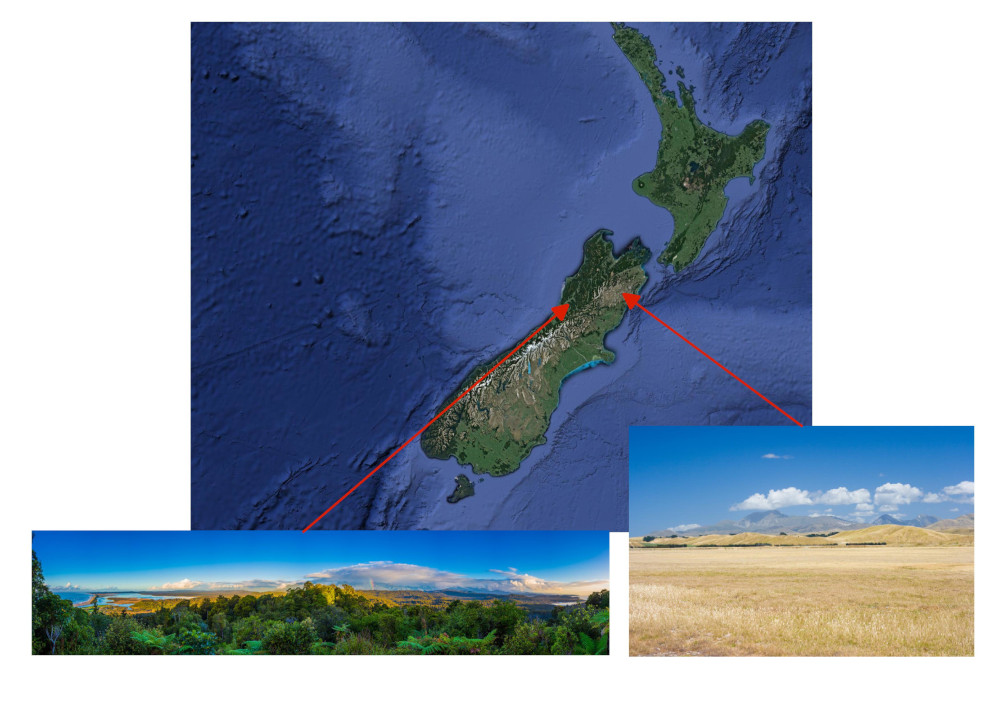
We have, for example, the Norwester (local Foehn wind name) in New Zealand that cause desert condition in the Marlborough region.
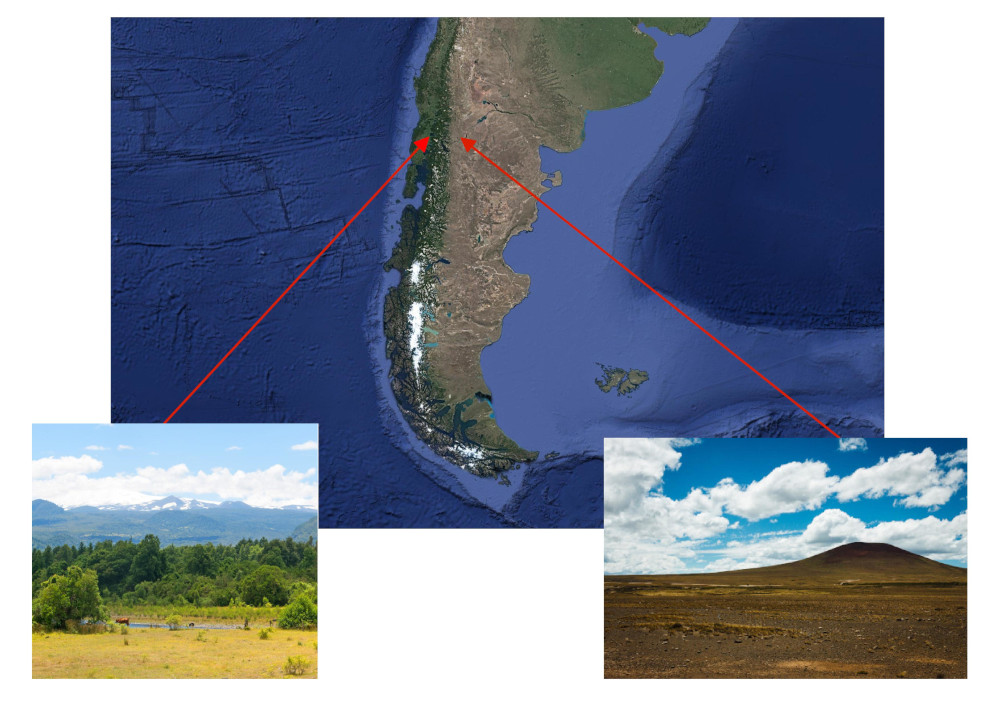
Another example of this is the Zonda (local name for the Foehn wind) in Chili and Argentina.
Foehn and Chinook winds?
Chinook winds are a local name for Foehn winds and it is used for the winds on the east sides of the Rocky Mountains in North America.
Foehn wind and other names?
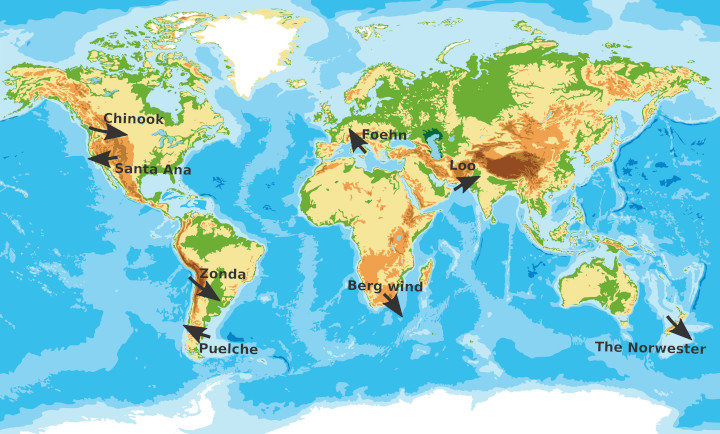
We saw in the previous chapter that Chinook winds are a local name for Foehn winds, but there are other local names for this type of wind. Here is a list of some of them:
| Continent | Name | Location |
|---|---|---|
| Africa | Berg wind | South Africa |
| Asia | Loo | Indo-Gangetic Plain |
| Warm Braw | Schouten Islands north of West Papua, Indonesia | |
| Europe | Foehn | Alps |
| Fogony | Catalan Pyrenees | |
| Halny | Carpathian Mountains | |
| Helm | Cumbria, England | |
| North America | Chinook | East of the Rocky Mountains in Canada and the United States |
| Santa Ana | Southern California | |
| Oceania | The Norwester | East coast of New Zealand |
| Sout America | Puelche | Eastern wind that occurs in south-central Chile |
| Zonda | Eastern slope of the Andes in Argentina |
Foehn wind health effects
Following local believing, Foehn wind is linked with increased mental illness and states like aggressiveness, depression, suicide, anxiety, headaches, psychosis, …
Some modern studies are studying these believing and have shown an increase in suicides and accidents during episodes of Foehn.